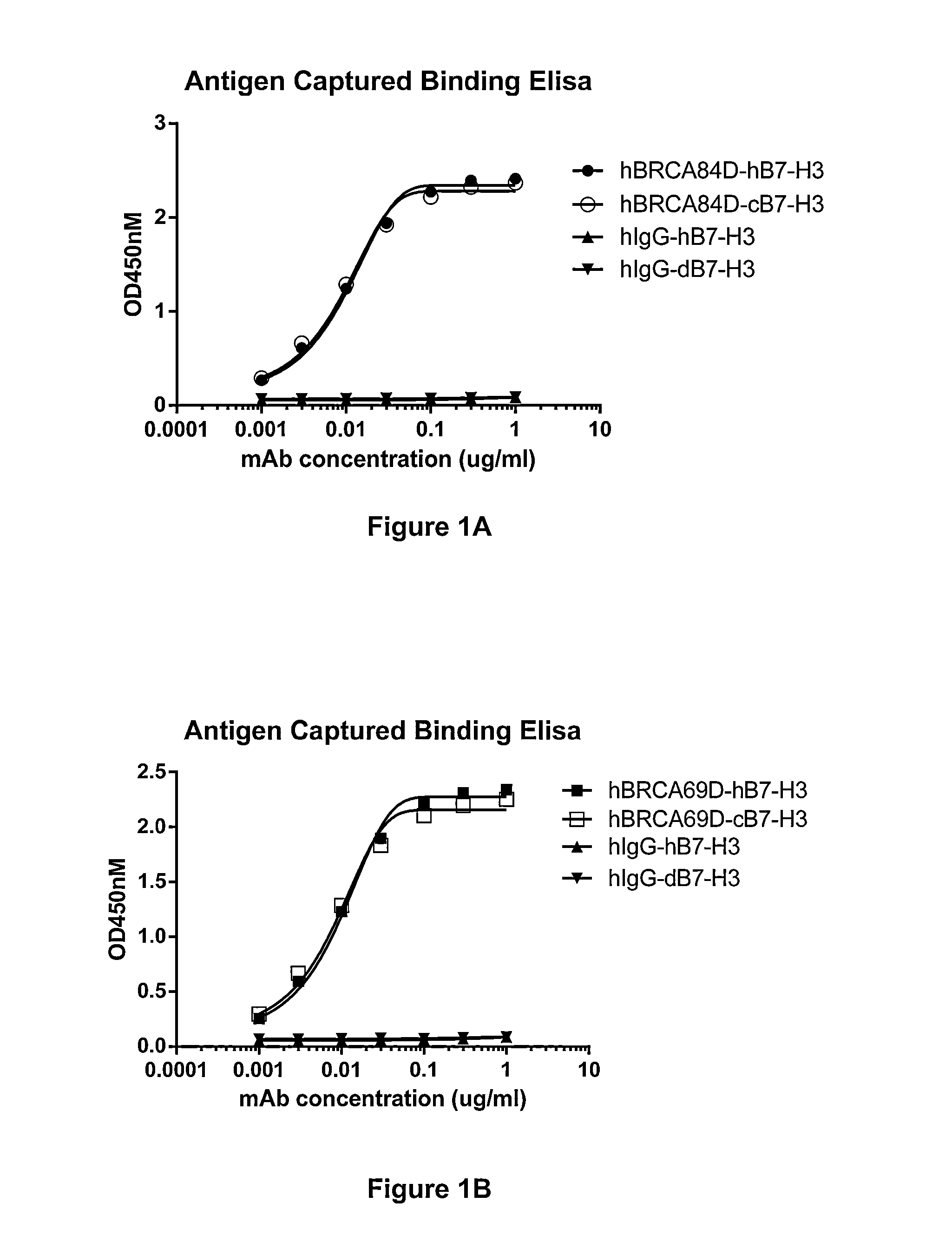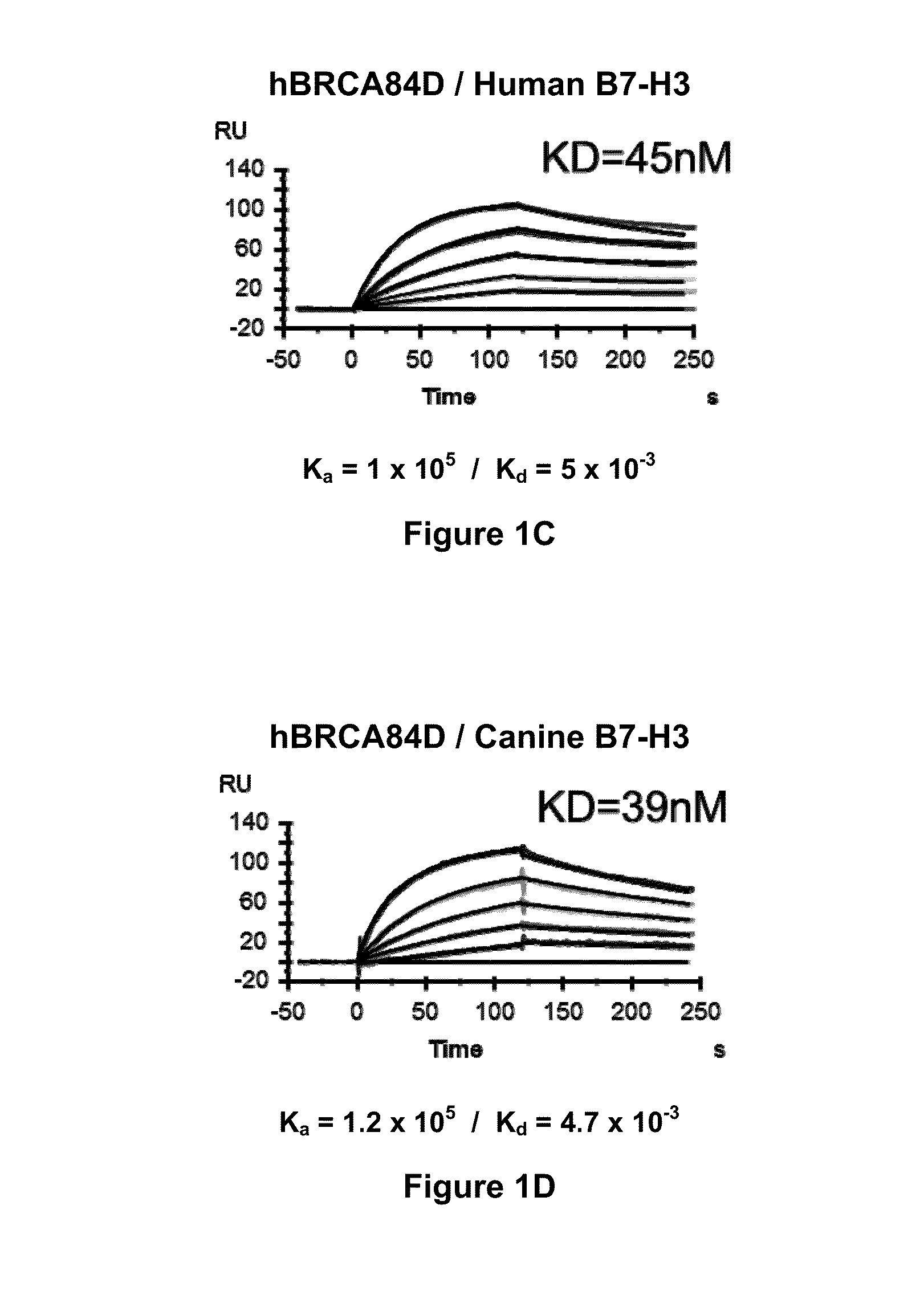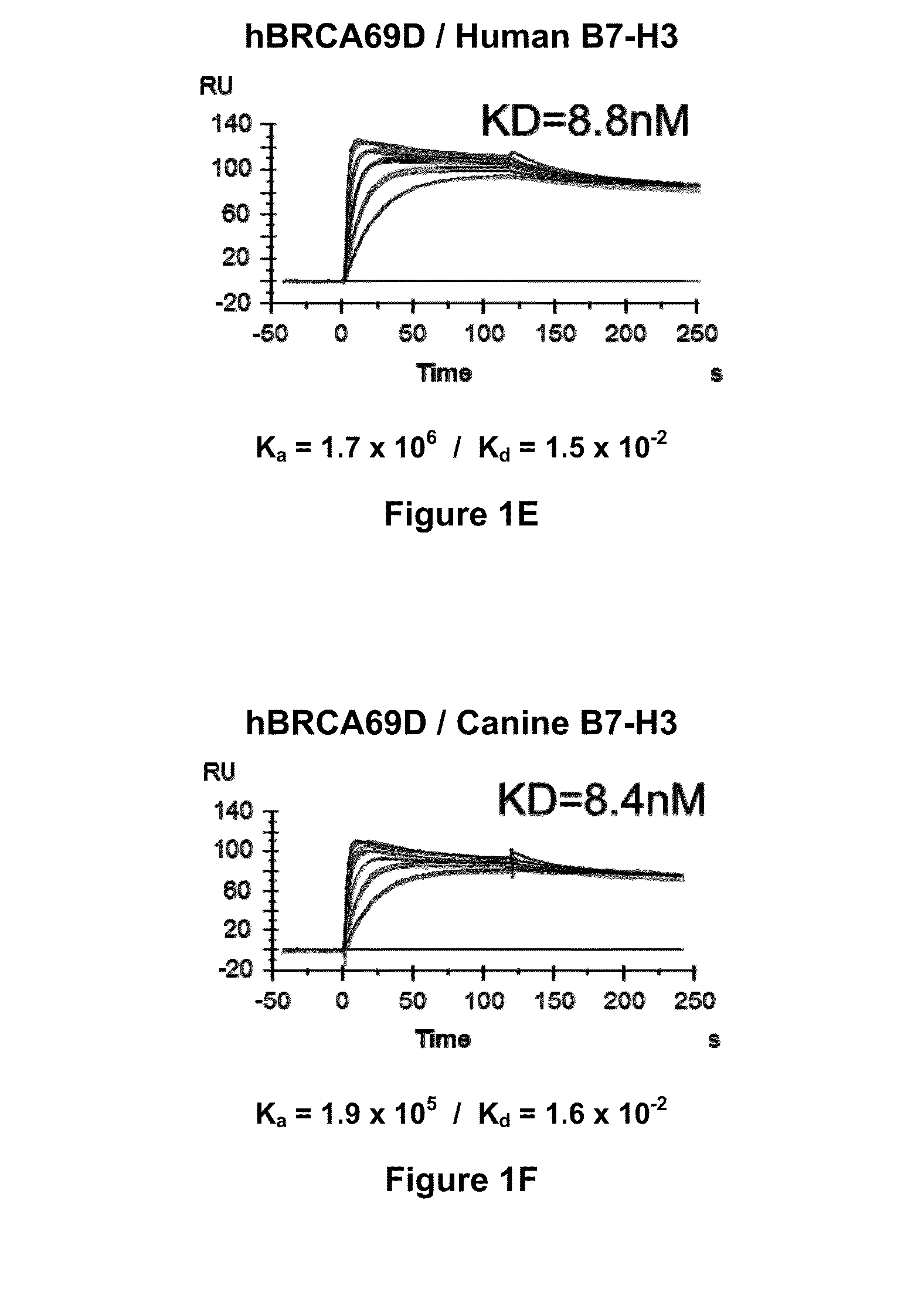Bispecific Molecules That Are Immunoreactive with Immune Effector Cells of a Companion Animal That Express an Activating Receptor and Cells That Express B7-H3 and Uses Thereof
a technology of immune effector cells and bispecific molecules, which is applied in the field of bispecific molecules, can solve the problems of insufficient immune response and domestication canine death, and achieve the effects of facilitating the killing of cancer cells, enhancing, activating and targeting
- Summary
- Abstract
- Description
- Claims
- Application Information
AI Technical Summary
Benefits of technology
Problems solved by technology
Method used
Image
Examples
example 1
Ability of Human B7-H3 Antibody to Bind Canine B7-H3
[0315]Antibodies hBRCA84D and hBRCA69D were tested in an ELISA for binding to canine B7-H3. Briefly, soluble human B7-H3 and canine B7-H3 were expressed in CHO cells. Each soluble molecule was engineered to express a 6×His tag at the carboxy terminus to aid in purification of the expressed protein. The molecules were purified by nickel column chromatography using standard techniques. ELISA plates were coated with the soluble B7-H3 and allowed to dry. The plates were washed and blocked using standard ELISA techniques. The wells were probed with either hBRCA84D, hBRCA69D or a control hIgG. Secondary detection reagent was added and binding was determined As shown in FIG. 1A (hBRCA84D) and FIG. 1B (hBRCA69D), the antibodies were able to bind to soluble canine B7-H3 (cB7-H3). To determine binding affinity of the hBRCA84D and hBRCA69D antibodies to soluble canine B7-H3, SPR analysis was conducted. As shown in FIGS. 1C and 1D (hBRCA84D) a...
example 2
Ability of Anti-Human B7-H3 Antibody to Bind Canine and Feline B7-H3 in Tumor Tissues
[0316]Antibody BRCA69D was evaluated for its ability to bind to B7-H3 receptor of canine and feline in tumor tissues. The results of IHC analyses for feline cancer tissue are shown in Table 2 and Table 3.
TABLE 2Feline IHC SummaryDiagnosisPositive Rate≧ 2 + Positive RateFibrosarcoma20% (1 / 5) 0% (0 / 5)Mammary Carcinoma60% (3 / 5)40% (2 / 5)Squamous Cell Carcinoma 80% (4 / 5)80% (4 / 5)
[0317]As disclosed in Table 2, BRCA69D was found to be able to bind to the feline B7-H3 receptor in tumor tissue samples and to accurately detect feline cancer tissue. Thus, BRCA69D may be used to diagnose and detect feline cancers associated with B7-H3 expression, in the same manner as it may be used be used to diagnose and detect human cancers associated with B7-H3 expression. Representative biopsy sections are shown in FIG. 2.
[0318]Table 3 presents the results of IHC studies of the ability of BRCA69D to bind to the canine B7-H...
example 3
Bispecific Molecules Specific for B7-H3 and CD3 Mediate Potent Redirected T-Cell Killing
[0320]Bispecific molecules specific for canine CD3 and B7-H3 (K9CD3×B7-H3) were prepared as a dual affinity retargeting (DART) diabody reagents. Such bispecific molecules have the ability to localize a T-cell (by binding such T-cell to the CD3 portion of a CD3-binding bispecific molecule) to the location of a cancer cell (by binding such cancer cell to the B7-H3 binding portion of the bispecific molecule). The localized T-cell can then mediate the killing of the cancer cell in a process termed “redirected” killing.
[0321]The K9CD3×B7-H3 bispecific molecule was constructed having the anti-CD3 variable domains of K9CD3-1 and the anti-B7-H3 variable domains of hBRCA84D-2:
[0322]Chain 1 sequence (SEQ ID NO:138):
DIQLTQSPSF LSASVGDRVT ITCKASQNVD TNVAWYQQKPGKAPKALIYS ASYRYSGVPS RFSGSGSGTD FTLTISSLQPEDFATYYCQQ YNNYPFTFGQ GTKLEIKGGG SGGGGEVQLQQSGPELVKPG ASVKISCKAS GYTFSDYNMH WVKQSHGESLEWIGYIYPYN GGTYYNQKFK ...
PUM
 Login to View More
Login to View More Abstract
Description
Claims
Application Information
 Login to View More
Login to View More - R&D
- Intellectual Property
- Life Sciences
- Materials
- Tech Scout
- Unparalleled Data Quality
- Higher Quality Content
- 60% Fewer Hallucinations
Browse by: Latest US Patents, China's latest patents, Technical Efficacy Thesaurus, Application Domain, Technology Topic, Popular Technical Reports.
© 2025 PatSnap. All rights reserved.Legal|Privacy policy|Modern Slavery Act Transparency Statement|Sitemap|About US| Contact US: help@patsnap.com



